1
Section One: The Fundamentals
A) What do we know about sport? What are common assumptions we make about sport and society?

| While the idea of sports promoting teamwork and unity is often seen, this is not always the case. This version of sports assumes activities which guarantee inclusion, cooperation, and respect. In reality, structural, social, and cultural factors more often overtake these values, leading to exclusion or division.
For example, sports participation might be restricted due to socioeconomic issues, especially for people from poorer or marginalized communities. In some sports, kids who are not able to afford expensive equipment, training, or travel fees feel left out within their teams. Financial disparities among teammates can result in resentment or exclusion, as teammates receiving more support have greater opportunities for development and success. Cultural differences can also be seen in sports. It is not uncommon that athletes from minority ethnic or racial groups face microaggressions, stereotyping, or racism from teammates, coaches, or fans. This can lead to tension and mistrust among teammates instead of unity. For example, a player from a cultural background may feel excluded if their teammates make them feel that their traditions, language, or beliefs are unimportant. The pressure of performing in highly competitive environments can deter teamwork. Individual ambitions for recognition, scholarships, or professional opportunities may create cliques, favouritism, or conflicts among players. This is most evident in sports like tennis or gymnastics, where athletes train in an individual capacity but compete in teams. The emphasis on competition and winning can undermine unity. After losses, teammates might blame one another, or prioritize personal performance over team success. These dynamics can change the ideal of sports being unifying. |
Exercise 3: Notebook prompt
What are some other metanarratives about sport that you are familiar with? Find an image or video clip or draw something yourself that captures this idea…
So what? Why does any of this matter? Does it matter? As something we grow up with – live with – play through – we don’t often interrogate the meanings of sport, and perhaps we don’t want to.
But being aware of these assumptions and metanarratives is especially important, I would argue, because of the centrality of sport to our everyday lives, the role that sport plays in shaping our childhood and worldviews and….. [finish that thought]
| Metanarratives involve large, framing stories or cultural assumptions in which the world is read or understood, sport is no exception. Of these, one rather well-received metanarrative involves the so-called “American Dream” through sports. This would claim that athletic talent and hard work are sufficiently important to succeed and achieve fame, fortune, and social mobility. This narrative suggests that sports offer a certain pathway to success, where anyone, regardless of their socioeconomic background, can achieve fame, wealth, and respect through hard work and dedication. Athletes like Michael Jordan or Simone Biles are often used as symbols of this idea, celebrated for their perseverance and exceptional talent.
Another metanarrative is that of “sport as diplomacy.” Events such as Ping Pong Diplomacy from the 1970s, for instance, show how table tennis helped reduce friction between America and China. The symbolic image of shaking hands between North and South Korean athletes at an Olympic ceremony presents unity above all politics. These metanarratives matter because they shape societal values and our understanding of sports’ role in culture. The emphasis on competition and individual achievement can sometimes weaken values like teamwork or progress. Narratives about sports uniting people may bury deeper inequalities within the structures of sport itself. Recognizing these stories allows us to critically evaluate how sports shape our worldview and influence social dynamics. |
B) What is social justice?
Exercise 4: Padlet Prompt
Think back to the last section and try to look at some of the ideas we discussed differently. How might sport and social justice actually co-exist?
Record any images, video clips, or gifs you added to the padlet and identify a point of intersection between sport and social justice (can be an issue or a barrier or a debate or something you would like to explore in more depth in this course) . Screenshot or paste in your response below.
|
Access and opportunity are very important, as sporting activities often reflect the inequalities within society. It would bridge the gap if sports were featured in the school curriculum, and would be freely available to students of all incomes. This will ensure that economic status does not limit access but there is also early exposure to youth for trying various forms of sport. Another approach is investments in disadvantaged communities by building multi-use facilities that can adapt to different sports and abilities. Facilities would be designed with inclusivity in mind, using adaptive sports equipment like basketball wheelchairs or skate park ramps, in such a way as to assure equal service, access, and opportunities for people with disabilities. Professional sports organizations and programs could also help to extend access. For example, professional leagues could mentor or sponsor programs in poorer or marginalized areas, providing both funding and visibility to the local initiative. Athletes can play an important role, using their platforms to raise awareness and interact with participants. |
C) Social Justice Reading
D) KINESIOLOGY AND SOCIAL JUSTICE
Exercise 5:
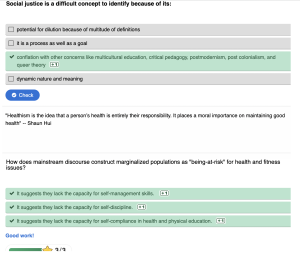
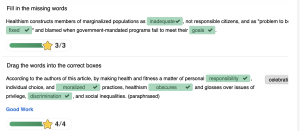
Exercise 6:
What are the implications of bodies-at-risk discourse and the refusal to understand the health gap from a social justice perspective, according to the authors of this article?
| According to Harrison, Azzarito, and Hodge, the bodies-at-risk discourse frames health as an individual responsibility, often detached from the broader social, economic, and cultural factors that shape health outcomes. This supports the idea that health maintenance is a matter of personal obligation, blaming individuals for poor health outcomes while systemic inequities are ignored that produce health disparities. A narrative like this creates stigma, especially among the most marginalized groups, which often bear a disproportionate burden of structural contributions of health such as poverty, lack of health care access, and discrimination.
This can further the inequality angle in health by not considering its issue a social justice concern. Health, as it may be seen as a free market in many places, can no longer concern well-being as it has become profit-based. For example, fitness industries, diet programs, and even healthcare providers make use of this “responsibility rhetoric,” selling products and services to people by putting all choices into consumer’s hands. The implications of this article extend beyond this. The emphasis on individual responsibility, it diverts attention away from systemic racism, economic inequality, and environmental injustices, all of which underline health inequity. It keeps those already marginalized in a circle of responsibility for things they have no control over. Such a perspective works to marginalize those labelled “at risk,” at times devaluing persons who exist in outliers of societal norms around health and fitness. From a social justice perspective, health disparity calls for a change in the narrative, health needs to be reframed as a social responsibility in which the narrative shifts to dismantle systemic inequities and create equal opportunities regarding healthcare, education, and resources. It is from this perspective that societies can make their way toward truly inclusive health outcomes, where the values and support for all people move beyond their social and economic standings. |
Section Two: Sport Feminism
Exercise 7: Notebook Prompt
What is feminism? What does it mean to you? Choose one of the images below and explain how it captures your understanding of feminism (or find one that does speak to you and paste this into your pressbook with an explanation of why it matters to you.
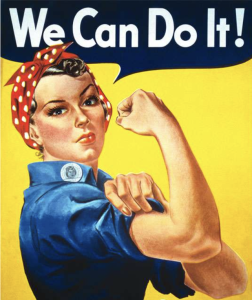
| At the core of feminism, there is equitability and justice. It not only tries to tear down the systems of oppression that keep gender inequality going but also is multidimensional, acknowledging the role played by race, class, sexuality, and all other social variables that alter the individual experience of oppression. To me, feminism is the challenge against the normalities which show what is acceptable or possible for one to be based on gender, especially in sports fields that are typically filled with mainly men.
The picture of a flexing, confident woman under the slogan “We Can Do It!” also known as Rosie the Riveter, speaks to me about feminism. The original was a World War II call to women to enter the workforce, the image has since been used in various contexts as a symbol of women’s strength and resilience. This is indicative of the feminist character to break barriers and show the world that women, too, are capable of doing tasks that consider the needs of men. This image also speaks directly to sport. Similar to the workforce, sports have been a very visible battleground in the fight for gender equity. For years, women athletes have fought to get equal opportunities, funding, and recognition for their sports. This imagery parallels campaigns like the U.S. Women’s Soccer Team for equal pay and Billie Jean King’s pioneering work in tennis. Fundamentally, feminism is not about women’s equality but the freedom for all of them to live without strict gender roles. If this point is taken within an inclusive and intersectional framework, we would be able to provide more equitable and enabling contexts in many aspects of life. |
Exercise 8: Notes Prompt (optional)
Exercise 9: Crossword Activity
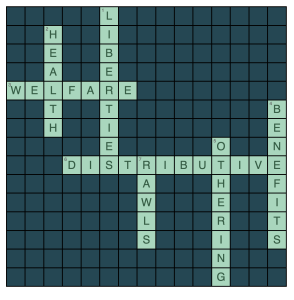
Exercise 10: Padlet Prompt
| Liberal feminism seeks to provide equal opportunities for women in sports through the breakdown of systemic barriers and socialization practices that limit participation. This emphasizes equal access to women in sports facilities, funding, and leadership positions and challenges traditional notions of femininity that traditionally exclude women from many sports. The liberal feminist supports policy reforms, which have been important to increase female participation in athletics with requirements for schools and sports programs to adopt gender equity. Such a perspective also criticizes the wide pay and media representation gap for women athletes, calling for change on both economic and cultural levels to give women the same recognition and value. Though it has its criticisms for staying within the system and not going deeper to realize the intersectional causes, liberal feminism has played a great role in ensuring women’s rights in sports. It tries to push for more open processes, access, representation, and opportunity for all women. |
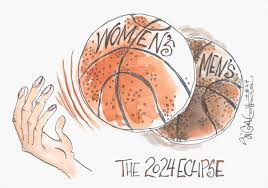
| I totally believe the landscape for women’s sports is changing, and it’s a great thing to see. Obviously, athletes like Angel Reese and Caitlin Clark have shown great talent and have created interest in women’s sports. The performances of the duo during the NCAA Women’s Basketball Tournament made many take notice across the globe and broke viewership records, showing that people do care about women’s sports.
However, this change isn’t just about the individual athletes, it’s a representation of a broader movement. Professional leagues like the PWHL and the FIFA Women’s World Cup continue to attract record crowds and media attention, indicative of changes in society’s perceptions of women’s sports. At the same time, social media has also played a big role in boosting those highlights, stories, and milestones that went unnoticed previously. However, the symbolic image of the “women’s” basketball eclipsing the “men’s” basketball reminds us that there is still significant work to be done. Women’s sports remain underfunded, under-promoted, and often undervalued compared to men’s. Persistent issues like unequal pay, limited sponsorships, and insufficient media coverage continue to create barriers. While this might be a promising trend, investment is still needed along with better representation and concerted efforts by fans, organizations, and the media alike for women’s sports to receive the respect and visibility they deserve. |

